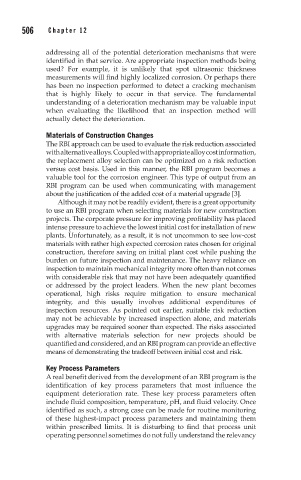Page 540 - Corrosion Engineering Principles and Practice
P. 540
506 C h a p t e r 1 2 C o r r o s i o n a s a R i s k 507
addressing all of the potential deterioration mechanisms that were
identified in that service. Are appropriate inspection methods being
used? For example, it is unlikely that spot ultrasonic thickness
measurements will find highly localized corrosion. Or perhaps there
has been no inspection performed to detect a cracking mechanism
that is highly likely to occur in that service. The fundamental
understanding of a deterioration mechanism may be valuable input
when evaluating the likelihood that an inspection method will
actually detect the deterioration.
Materials of Construction Changes
The RBI approach can be used to evaluate the risk reduction associated
with alternative alloys. Coupled with appropriate alloy cost information,
the replacement alloy selection can be optimized on a risk reduction
versus cost basis. Used in this manner, the RBI program becomes a
valuable tool for the corrosion engineer. This type of output from an
RBI program can be used when communicating with management
about the justification of the added cost of a material upgrade [3].
Although it may not be readily evident, there is a great opportunity
to use an RBI program when selecting materials for new construction
projects. The corporate pressure for improving profitability has placed
intense pressure to achieve the lowest initial cost for installation of new
plants. Unfortunately, as a result, it is not uncommon to see low-cost
materials with rather high expected corrosion rates chosen for original
construction, therefore saving on initial plant cost while pushing the
burden on future inspection and maintenance. The heavy reliance on
inspection to maintain mechanical integrity more often than not comes
with considerable risk that may not have been adequately quantified
or addressed by the project leaders. When the new plant becomes
operational, high risks require mitigation to ensure mechanical
integrity, and this usually involves additional expenditures of
inspection resources. As pointed out earlier, suitable risk reduction
may not be achievable by increased inspection alone, and materials
upgrades may be required sooner than expected. The risks associated
with alternative materials selection for new projects should be
quantified and considered, and an RBI program can provide an effective
means of demonstrating the tradeoff between initial cost and risk.
Key Process Parameters
A real benefit derived from the development of an RBI program is the
identification of key process parameters that most influence the
equipment deterioration rate. These key process parameters often
include fluid composition, temperature, pH, and fluid velocity. Once
identified as such, a strong case can be made for routine monitoring
of these highest-impact process parameters and maintaining them
within prescribed limits. It is disturbing to find that process unit
operating personnel sometimes do not fully understand the relevancy

